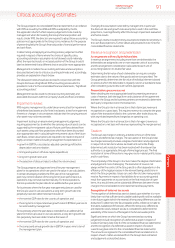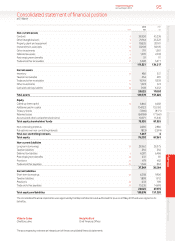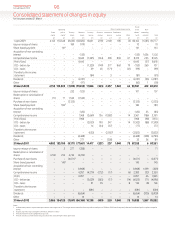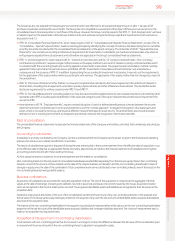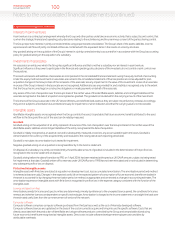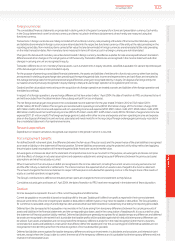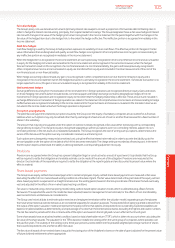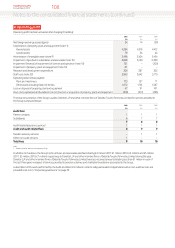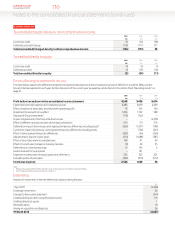Vodafone 2012 Annual Report Download - page 102
Download and view the complete annual report
Please find page 102 of the 2012 Vodafone annual report below. You can navigate through the pages in the report by either clicking on the pages listed below, or by using the keyword search tool below to find specific information within the annual report.
100
Vodafone Group Plc
Annual Report 2012
Notes to the consolidated nancial statements (continued)
Interests in joint ventures
A joint venture is a contractual arrangement whereby the Group and other parties undertake an economic activity that is subject to joint control; that
is, when the strategic nancial and operating policy decisions relating to the activities require the unanimous consent of the parties sharing control.
The Group reports its interests in jointly controlled entities using proportionate consolidation. The Group’s share of the assets, liabilities, income,
expenses and cash ows of jointly controlled entities are combined with the equivalent items in the results on a line-by-line basis.
Any goodwill arising on the acquisition of the Group’s interest in a jointly controlled entity is accounted for in accordance with the Group’s accounting
policy for goodwill arising on the acquisition of a subsidiary.
Investments in associates
An associate is an entity over which the Group has signicant inuence and that is neither a subsidiary nor an interest in a joint venture.
Signicantinuence is the power to participate in the nancial and operating policy decisions of the investee but is not control or joint control over
those policies.
The results and assets and liabilities of associates are incorporated in the consolidated nancial statements using the equity method of accounting.
Under the equity method, investments in associates are carried in the consolidated statement of nancial position at cost as adjusted for post-
acquisition changes in the Group’s share of the net assets ofthe associate, less any impairment in the value of the investment. Losses of an associate
in excess of the Group’s interest in that associate are not recognised. Additional losses are provided for, and a liability is recognised, only to the extent
that the Group has incurred legal or constructive obligations or made payments on behalf of the associate.
Any excess of the cost of acquisition over the Group’s share of the net fair value of the identiable assets, liabilities and contingent liabilities of the
associate recognised at the date of acquisition is recognised as goodwill. The goodwill is included within the carrying amount of the investment.
The licences of the Group’s associate in the US, Verizon Wireless, are indenite lived assets as they are subject to perfunctory renewal. Accordingly,
they are not subject to amortisation but are tested annually for impairment, or when indicators exist that the carrying value is not recoverable.
Intangible assets
Identiable intangible assets are recognised when the Group controls the asset, it is probable that future economic benets attributed to the asset
will ow to the Group and the cost of the asset can be reliably measured.
Goodwill
Goodwill arising on the acquisition of an entity represents the excess of the cost of acquisition over the Group’s interest in the net fair value of the
identiable assets, liabilities and contingent liabilities of the entity recognised at the date of acquisition.
Goodwill is initially recognised as an asset at cost and is subsequently measured at cost less any accumulated impairment losses. Goodwill is
denominated in the currency of the acquired entity and revalued to the closing rate at each reporting period date.
Goodwill is not subject to amortisation but is tested for impairment.
Negative goodwill arising on an acquisition is recognised directly in the incomestatement.
On disposal of a subsidiary or a jointly controlled entity, the attributable amount of goodwill is included in the determination of the prot or loss
recognised in the income statement on disposal.
Goodwill arising before the date of transition to IFRS, on 1 April 2004, has been retained at the previous UK GAAP amounts, subject to being tested
for impairment at that date. Goodwill written off to reserves under UK GAAP prior to 1998 has not been reinstated and is not included in determining
any subsequent prot or loss ondisposal.
Finite lived intangible assets
Intangible assets with nite lives are stated at acquisition or development cost, less accumulated amortisation. The amortisation period and method
is reviewed at least annually. Changes in the expected useful life or the expected pattern of consumption of future economic benets embodied in
the asset is accounted for by changing the amortisation period or method, as appropriate, and are treated as changes in accounting estimates. The
amortisation expense on intangible assets with nite lives is recognised in prot or loss in the expense category consistent with the function of the
intangible asset.
Licence and spectrum fees
Amortisation periods for licence and spectrum fees are determined primarily by reference to the unexpired licence period, the conditions for licence
renewal and whether licences are dependent on specic technologies. Amortisation is charged to the income statement on a straight-line basis over
the estimated useful lives from the commencement of service of the network.
Computer software
Computer software comprises computer software purchased from third parties as well as the cost of internally developed software.
Computersoftware licences are capitalised on the basis of the costs incurred to acquire and bring into use the specic software. Costs that are
directly associated with the production of identiable and unique software products controlled by the Group, and are probable of producing
futureeconomic benets are recognised as intangible assets. Direct costs include software development employee costs and directly
attributableoverheads.
2. Signicant accounting policies (continued)



